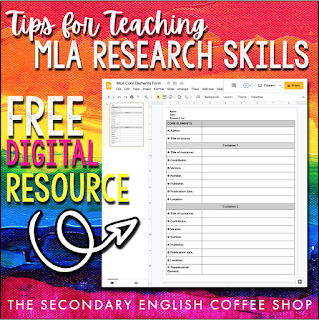by Tracee Orman
Teaching students how to properly cite their sources can be an exhausting and overwhelming experience. For years I just taught MLA (Modern Language Association) style while students were actively gathering research, assuming they had the basics down. But what I’d find is too many students forgot how to, didn’t grasp it the first time, or just didn’t care enough to learn. So I would find myself repeating things over and over and, in some cases, just doing it for them. 🤦🏻♀️ Not my proudest teaching moments.
After a few years of repeating this pattern and basically dreading the annual research paper unit, I created a series of exercises for my students BEFORE assigning any sort of topic for research. Here are my step-by-step procedures for teaching MLA style:
1. Explain to students what the Modern Language Association (MLA) is and why it’s important to use when writing. Students need to understand that documenting their sources is required and essential for academic writing. If your department/school/district has a plagiarism policy, this is the time to discuss it and emphasize the consequences of plagiarism. If you need help with this step (and the others), I have a handout that covers this with follow-up comprehension check questions.
2. After we go over the importance of using MLA style, I start with teaching in-text citations and signal phrases. I give students several examples but you can also just choose blurbs from your local paper or an online news site like Newsela or The Learning Network via The New York Times. Give students the basic information (author, title, publication, date) along with a quote and have them practice writing a signal phrase to introduce the quote. They should get the hang of it after a few tries.
3. Once students have mastered signal phrases, it’s time to teach them how to paraphrase and use parenthetical citations. This skill is definitely more difficult for some students to grasp. I provide students with small blurbs from articles and resources for practice. It’s much less overwhelming than working with longer texts. Remind them that their paraphrased passages should not have the same exact words or key words as the original (unless they are necessary, in which case they should be in quotation marks); instead, they should use synonyms and restructure the sentence. They should also check that the meaning of the passage is the same but just reworded.
4. The next step is practicing how to locate the core elements in a source. In the previous examples, I had provided those for them. But in these exercises, I have screenshots of sources and they have to find all the core elements that are provided. Again, you can use your own articles and resources and have students pick out the core elements. You can use my FREE digital resource for this exercise (make sure you first make a copy in your Drive, THEN share with students--most districts do not allow students to save a copy from an outside source). Make sure students know it is OK to skip elements that are not used in a resource.
5. When students can easily recognize the core elements in a variety of resources, have them write a works cited entry for each of them. If they used the core elements form, they can go right in order from top to bottom using the same punctuation after each element. Give them examples on how to format them and put them in alphabetical order.
6. At this point, I provide examples of the formatting of a final paper (font/size, margins, header, title, etc.), as well as examples of almost 30 different citations for a wide variety of resources. This way they will have an arsenal of examples to use while they are researching their own topic.
7. The final step is to assign topics and allow students to begin their research and writing process. Of course, this step definitely takes the longest and could be broken up into many additional steps, so I will save that for another post!
I hope this post helps you navigate teaching MLA and makes the experience easier and less stressful! Please feel free to contact me anytime with any questions you may have.
My friends here at the Coffee Shop have additional resources you may find helpful:
MLA Citation Guide Mini-Book by The Classroom Sparrow
Research Magazine by Room 213
Research Project--Real Life Utopias by Nouvelle ELA
MLA Format Escape Room Activity by The Daring English Teacher













